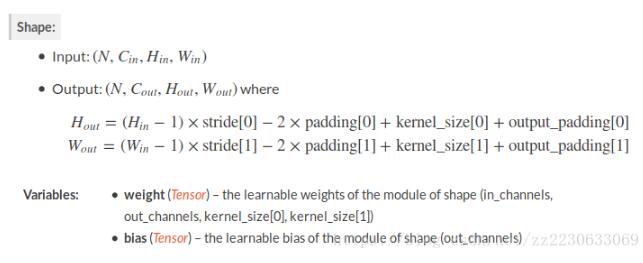pytorch中的上采样以及各种反操作,求逆操作详解
2020-02-13 10:06
656 查看
import torch.nn.functional as F
import torch.nn as nn
F.upsample(input, size=None, scale_factor=None,mode='nearest', align_corners=None)
r"""Upsamples the input to either the given :attr:`size` or the given :attr:`scale_factor` The algorithm used for upsampling is determined by :attr:`mode`. Currently temporal, spatial and volumetric upsampling are supported, i.e. expected inputs are 3-D, 4-D or 5-D in shape. The input dimensions are interpreted in the form: `mini-batch x channels x [optional depth] x [optional height] x width`. The modes available for upsampling are: `nearest`, `linear` (3D-only), `bilinear` (4D-only), `trilinear` (5D-only) Args: input (Tensor): the input tensor size (int or Tuple[int] or Tuple[int, int] or Tuple[int, int, int]): output spatial size. scale_factor (int): multiplier for spatial size. Has to be an integer. mode (string): algorithm used for upsampling: 'nearest' | 'linear' | 'bilinear' | 'trilinear'. Default: 'nearest' align_corners (bool, optional): if True, the corner pixels of the input and output tensors are aligned, and thus preserving the values at those pixels. This only has effect when :attr:`mode` is `linear`, `bilinear`, or `trilinear`. Default: False .. warning:: With ``align_corners = True``, the linearly interpolating modes (`linear`, `bilinear`, and `trilinear`) don't proportionally align the output and input pixels, and thus the output values can depend on the input size. This was the default behavior for these modes up to version 0.3.1. Since then, the default behavior is ``align_corners = False``. See :class:`~torch.nn.Upsample` for concrete examples on how this affects the outputs. """
nn.ConvTranspose2d(in_channels, out_channels, kernel_size, stride=1, padding=0, output_padding=0, groups=1, bias=True, dilation=1)
""" Parameters: in_channels (int) – Number of channels in the input image out_channels (int) – Number of channels produced by the convolution kernel_size (int or tuple) – Size of the convolving kernel stride (int or tuple, optional) – Stride of the convolution. Default: 1 padding (int or tuple, optional) – kernel_size - 1 - padding zero-padding will be added to both sides of each dimension in the input. Default: 0 output_padding (int or tuple, optional) – Additional size added to one side of each dimension in the output shape. Default: 0 groups (int, optional) – Number of blocked connections from input channels to output channels. Default: 1 bias (bool, optional) – If True, adds a learnable bias to the output. Default: True dilation (int or tuple, optional) – Spacing between kernel elements. Default: 1 """
计算方式:

定义:nn.MaxUnpool2d(kernel_size, stride=None, padding=0)
调用:
def forward(self, input, indices, output_size=None): return F.max_unpool2d(input, indices, self.kernel_size, self.stride, self.padding, output_size)
r"""Computes a partial inverse of :class:`MaxPool2d`.
:class:`MaxPool2d` is not fully invertible, since the non-maximal values are lost.
:class:`MaxUnpool2d` takes in as input the output of :class:`MaxPool2d`
including the indices of the maximal values and computes a partial inverse
in which all non-maximal values are set to zero.
.. note:: `MaxPool2d` can map several input sizes to the same output sizes.
Hence, the inversion process can get ambiguous.
To accommodate this, you can provide the needed output size
as an additional argument `output_size` in the forward call.
See the Inputs and Example below.
Args:
kernel_size (int or tuple): Size of the max pooling window.
stride (int or tuple): Stride of the max pooling window.
It is set to ``kernel_size`` by default.
padding (int or tuple): Padding that was added to the input
Inputs:
- `input`: the input Tensor to invert
- `indices`: the indices given out by `MaxPool2d`
- `output_size` (optional) : a `torch.Size` that specifies the targeted output size
Shape:
- Input: :math:`(N, C, H_{in}, W_{in})`
- Output: :math:`(N, C, H_{out}, W_{out})` where
计算公式:见下面
Example: 见下面
"""

F. max_unpool2d(input, indices, kernel_size, stride=None, padding=0, output_size=None)
见上面的用法一致!
def max_unpool2d(input, indices, kernel_size, stride=None, padding=0, output_size=None): r"""Computes a partial inverse of :class:`MaxPool2d`. See :class:`~torch.nn.MaxUnpool2d` for details. """ pass
以上这篇pytorch中的上采样以及各种反操作,求逆操作详解就是小编分享给大家的全部内容了,希望能给大家一个参考
您可能感兴趣的文章:
相关文章推荐
- pytorch中的上采样以及各种反操作,求逆操作
- WP7的XML操作详解:读取,过滤以及数据绑定
- android中的文件操作详解以及内部存储和外部存储
- WP7的XML操作详解:读取,过滤以及数据绑定
- Swift - HTTP网络操作库Alamofire使用详解1(配置,以及数据请求)
- 8天掌握EF的Code First开发系列之3 管理数据库创建,填充种子数据以及LINQ操作详解
- 关于Quartus构建nios软核以及eclipse建立c语言工程以及成功下载到FPGA芯片过程遇到的各种问题以及解决方法详解
- MongoDB各种查询操作详解
- 带头结点和不带头结点的单链表的尾插法以及各种操作
- Java对各种文件的操作详解
- ReactiveCocoa框架菜鸟入门——信号(Signal)详解 第二课:信号(Signal)的各种操作
- MongoDB基础命令以及操作示例详解
- ioctl、文件操作接口函数以及nand的升级模式的操作过程详解
- 自定义吐司以及Toast的各种用法,详解。教你学会使用各种各样的Toast
- WP7 XML操作详解:读取,过滤以及数据绑定
- Hive中创建表的各种方式以及区别详解
- 基于jquery select各种操作详解
- [置顶] 自定义吐司以及Toast的各种用法,详解。教你学会使用各种各样的Toast
- 详解JAVA POI导出EXCEL报表的操作(包括各种格式及样式的实现)
- Oracle数据库的概念(权限、角色)以及各种操作(创建表空间、创建表、查询、更新、删除、插入)和常用函数
